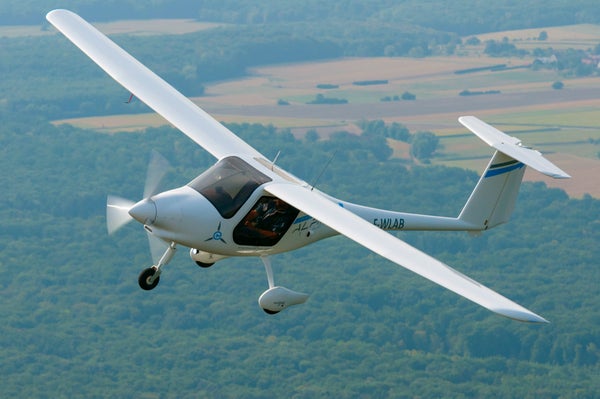CLIMATEWIRE | U.S. aviation company Textron Inc. announced last week that it will “accelerate” its development of an electric fleet, starting with the purchase of a Slovenian electric aircraft company.
Textron paid $235 million for Pipistrel, which produced the world’s first electric-powered aircraft to be internationally certified as being safe for passenger flights. Pipistrel will be part of a new division focused on the development of battery- and fuel-cell-powered electric aircraft.
Textron CEO Scott Donnelly predicted the merger will help make his company “a world leader in sustainable aircraft for a wide range of missions.” Textron produces Cessna and Beechcraft planes, as well as Bell helicopters.
The move is the latest in a growing global race to develop electric planes. The National Renewable Energy Laboratory estimates that 170 projects worldwide are focused on such planes — double the number underway in 2018.
A report from NREL — one of the laboratories that serves the Department of Energy — predicts the market could see “strong growth starting in 2028,” when the first 50- to 70-seat electric aircraft are expected to appear.
“It’s exciting to see all the different approaches that are being pursued,” said Jesse Bennett, an engineer and lead author of the NREL report. Projects range from small aircraft used to train new pilots and carry cargo to slightly larger planes that could ferry passengers from rural and small-town areas to major U.S. airports, he said.
The U.S. is home to 5,050 smaller airports that could serve as a niche for electric planes, which could be used to quickly move passengers to the 30 major airports serving larger U.S. cities.
That could require U.S. power grids to feed electric charging stations at the smaller airports. NASA also is currently investigating whether smaller airports may have enough vacant acreage for solar farms to refuel electric planes.
A NASA study published last year noted that wider use of electric aircraft would save fuel. From half to two-thirds of the energy in conventional jet or piston-powered aircraft “goes right out of the tailpipe,” it noted, while an electric motor uses 90 percent of the energy it gets from batteries to turn propellers.
Textron is one of several aircraft companies that see themselves pioneering a variety of profitable ways to use electric aircraft.
Boeing Co. is working with General Electric Aviation and NASA on modifying a conventional aircraft with electric turboprop engines to carry between 30 and 36 passengers.
Boeing is also investing $450 million in an electric air taxi, a small plane that can take off and land like a helicopter. It is being developed by Wisk, a company based in New Zealand and San Francisco, which sees a market in ferrying passengers to larger airports “with zero emissions.”
Wisk plans to develop passenger and cargo planes that can be flown autonomously, guided by pilots on the ground. In a January report, the company described its self-flying “eVTOL”, or electric vertical takeoff and landing air taxi, as a way for passengers to “skip the traffic and get to their destination faster.”
Airbus, another global aircraft manufacturer, is working in France to develop “EcoPulse,” a six-engine aircraft using higher voltage lithium-ion batteries.
From hang gliders to bats
In buying Pipistrel, Textron is inheriting the star power of its founder, Ivo Boscarol.
Boscarol entered the aircraft industry through his hobby: flying hang gliders. In the 1980s, a number of enthusiasts were trying to make the light, kite-like aircraft go faster and farther, but Boscarol, who ran a small photography business, beat them all, starting with small electric motors and a tricycle-like fuselage.
Flying unlicensed, motorized aircraft was illegal in Slovenia, but Boscarol smuggled one in from Italy and began to improve it, testing versions in the protective darkness of early evenings. Onlookers dubbed his contraption “pipistrel,” derived from the Italian word for bat.
“My philosophy is simple: Set the goals too high, or you are dead,” Boscarol told Plane & Pilot magazine in 2016. By then, Pipistrel had tried out thousands of variations of electric planes and found success in several designs.
In 2011, Pipistrel won a $1.1 million prize in a NASA-sponsored “green flight challenge” using lithium-ion polymer batteries. In 2020, the company introduced a two-seater with an enclosed cockpit called the Velis Electro. It is the first and, so far, only electric aircraft to receive full certification from the European Union’s Aviation Safety Agency.
According to Rob Scholl, who heads Textron's new division to make electric aircraft, Boscarol will be a consultant to help the Velis Electro break into the first emerging business for electric aircraft, which will be to train commercial pilots.
“He will be taking on with us as a chairman emeritus and will be a very valuable resource for us with customers and regulators,” Scholl said.
Training pilots is key to success, Scholl added.
“We’ll need to get used to flying in these aircraft,” he said. “What a lot of people underestimate is that commercial aviation has an incredibly safe track record. We’ve got to continue to work with the public to be comfortable with these new aircraft.”
Reprinted from E&E News with permission from POLITICO, LLC. Copyright 2022. E&E News provides essential news for energy and environment professionals.
